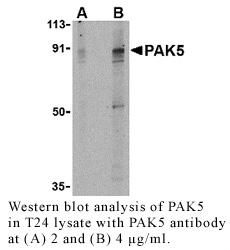Anti-Human P21-Activated Kinase 5 (PAK5)
| Code | Size | Price |
|---|
| LEI-P194-20ug | 20 ug | £199.00 |
Quantity:
| LEI-P194-0.1mg | 0.1 mg | £591.00 |
Quantity:
Prices exclude any Taxes / VAT
Overview
Host Type: Rabbit
Antibody Clonality: Polyclonal
Regulatory Status: RUO
Target Species: Human
Applications:
- Immunohistochemistry- Paraffin Embedded (IHC-P)
- Western Blot (WB)
Shipping:
Ambient
Storage:
This polyclonal antibody is stable for at least one week when stored at 2-8°C. For long term storage aliquot in working volumes without diluting and store at -20°C in a manual defrost freezer. Avoid Repeated Freeze Thaw Cycles.
Images
Further Information
Concentration:
0.5 mg/ml
Conjugate/Tag/Label:
Purified No Carrier Protein
Format:
This polyclonal antibody is formulated in phosphate buffered saline (PBS) pH 7.4 containing 0.02% sodium azide as a preservative.
Formulation:
This polyclonal antibody is formulated in phosphate buffered saline (PBS) pH 7.4 containing 0.02% sodium azide as a preservative.
Immunogen:
PN:P201
Long Description:
The p21-activated kinases (PAKs) are serine-threonine kinases that bind to the active forms of Cdc42 and Rac. They are divided into two groups, the first of which include PAK1, 2 and 3, and can be activated by Cdc42/Rac binding. Group 1 PAKs contain an autoinhibitory domain whose activity is regulated by Cdc42/Rac binding. The group 1 PAKs are known to be involved in cellular processes such as gene transcription, apoptosis, and cell morphology and motility. Much less is known about the second group, which includes PAK4, 5 and 6. These proteins are not activated by Cdc42/Rac binding. PAK5 was initially identified as a kinase expressed primarily in brain that while possessing a kinase domain and GTPase binding domain similar to PAK4 and PAK6, is completely different from both. Expression of PAK5 in neural based cell lines resulted in neurite outgrowth suggesting that PAK5 may be involved in regulating the cytoskeletal changes necessary for promoting neurite outgrowth. Other experiments suggest that unlike the other PAKs, PAK5 may inhibit apoptosis by phosphorylating the Bcl-2 family member Bad.
Target:
P21-Activated Kinase 5
References
1. Jaffer, ZM. et al. (2002) Int. J. Biochem. Cell Biol. 34:713 2. Yang, F. et al. (2001) J. Biol. Chem. 276:15345 3. Kaur, R. et al. (2005) J. Biol. Chem. 280:3323
Related Products
| Product Name | Product Code | Supplier | P21-Activated Kinase 5 Blocking Peptide | LEI-P201 | Leinco Technologies | Summary Details | |||||||||||||||||||||||||||||||||||||||||||||||||||||||||||||||||||||||||||||||||||||||||||||
|---|---|---|---|---|---|---|---|---|---|---|---|---|---|---|---|---|---|---|---|---|---|---|---|---|---|---|---|---|---|---|---|---|---|---|---|---|---|---|---|---|---|---|---|---|---|---|---|---|---|---|---|---|---|---|---|---|---|---|---|---|---|---|---|---|---|---|---|---|---|---|---|---|---|---|---|---|---|---|---|---|---|---|---|---|---|---|---|---|---|---|---|---|---|---|---|---|---|---|---|



